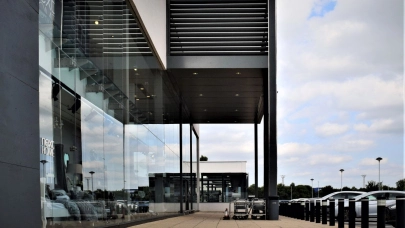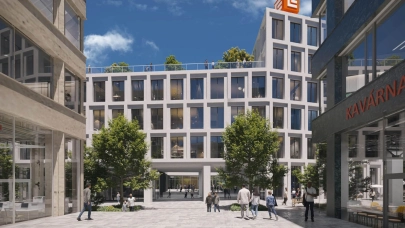
Cushman & Wakefield has summarised the situation on the Polish retail market for the third quarter of 2024, which saw a continuation of strong development activity, with new openings dominated by retail parks. The three months leading up to September marked the first quarter in the history of the Polish market in which one retail format accounted for the entire new supply. Retail market sentiment remained robust amid a growing number of brand debuts and strong retail sales, shopping centre footfall and turnover growth.
Supply: 102,000 sqm of new retail space comes onto the market in Q3
"The Polish retail sector witnessed strong development activity in the third quarter of 2024, with 102,000 sqm coming on stream. Retail parks accounted for all the new openings - these were developed both in large agglomerations and in towns with populations below 50,000. This brought Poland’s total retail stock to around 16.6 million sqm, with the total new supply for this year expected to reach around 460,000 sqm", comments Ewa Derlatka-Chilewicz, Head of Research, Cushman & Wakefield.
The largest retail park completions were BIG Gorzów and BIG Ostróda, each providing around 25,000 sqm of GLA. Additionally, San Park Piaseczno delivered approximately 18,500 sqm of modern retail space in Mysiadło. Together with the previously built Castorama, OBI, Biedronka and Selgros stores, it forms a retail complex with a total area of over 45,000 sqm of GLA. In addition, 5,700 sqm was added through the extensions of three retail parks in Radomsko, Skarżysko-Kamienna and Syców.
"There is currently 350,000 sqm under construction. The retail development pipeline comprises 44 projects, including 26 new buildings, 14 extensions and four redevelopments. The highest concentration of construction activity is in Silesia and Mazovia – 55,000 sqm and 54,000 sqm respectively. In addition, 37% of retail stock under development is in towns with populations below 50,000, and 43% in the largest agglomerations with over 400,000 inhabitants", says Ewelina Staruch, Senior Analyst, Cushman & Wakefield.
Demand: 10 new brands enter Poland
The third quarter of 2024 saw 10 brands enter the Polish retail market. The newcomers were: Arket, Bulgari, Carpatree, Dior Fashion, Dreame, GAP, Greek House, Rebernia, TAG Heuer, and Tissot. Seven of these brands opened their first stores in Warsaw.
Retail Sales: A strong third quarter
"Retail sales remained in positive territory in the third quarter of 2024, rising year-on-year by 4.4% in July and 2.6% in August, according to the latest data from Statistics Poland. In comparison, retail sales readings for the third quarter of last year were negative, with a 4.0% year-on-year drop in July and a 2.7% decline in August. In terms of the best-performing retail categories in constant prices in August 2024, motor vehicles, motorbikes and spare parts stood out, with sales up by 15.7% year-on-year, followed by other (+13.9%). Pharmaceuticals, cosmetics and orthopaedic equipment saw retail sales rise by 11.2% year-on-year", adds Ewa Derlatka-Chilewicz.
By contrast, annual falls in sales were reported for four categories. The biggest slump in business was recorded for textiles, clothing and footwear (-13.6% year-on-year), followed by furniture, radio, tv and home appliances (-5.3% year-on-year), newspapers and books (-1.9% year-on-year), as well as food, beverages and tobacco (-0.4% year-on-year).
"Consumer sentiment has improved over the year, leading to an increase in spending. The latest July reading of the Current Consumer Confidence Index (CCCI) was 10.9 pp higher than in July 2023", adds Ewelina Staruch.
In August 2024, Poland’s online retail penetration rate stood at 8.0%, up by 0.7 pp year-on-year. The best online performers were multimedia (newspapers, books and sales in specialised stores), fashion, furniture, radio, tv and home appliances.
Footfall & turnover: Consumer footfall and spend in shopping centres remain stable
The average shopping centre footfall for July-August 2024 was approximately 450,000 customers per retail scheme, a figure comparable to that posted in earlier years.
"The footfall index edged down by 1% year-on-year but was up by 4% compared to 2022. The best performers in terms of customer traffic year-on-year were the largest shopping centres, those with over 60,000 sqm of leasable area. Preliminary figures for September indicate a several percentage decline in footfall year-on-year, possibly due to exceptionally fine weather, which reduced the propensity to visit shopping centres and purchase autumn collections", explains Ewa Derlatka-Chilewicz.
The net turnover of shopping centre tenants in July-August 2024 averaged more than PLN 1,100 per square metre. The average nominal turnover for the third quarter of 2024 was up by 4% year-on-year, but in real terms - when accounting for inflation - it was roughly equal to last year’s. The strongest average nominal turnover growth of 5% was reported for the smallest shopping centres, translating into to a real turnover growth of around 1%.
Rents: Rental rates rise year-on-year across all three retail market segments
"Prime rents have shown a consistent upward trend. In the third quarter of 2024, monthly shopping centre rental rates averaged €155 per sqm, representing a year-on-year increase of 19%. Annual rental growth for high streets and retail parks was recorded at 19% and 23% respectively", comments Michał Masztakowski, Head of Retail Agency Poland, Cushman & Wakefield.
Vacancies: Poznań and Wrocław report the highest vacancy rates
A survey of Poland’s eight largest agglomerations has revealed that as of the third quarter of 2024, the average retail vacancy rate was 3.2%, down from 3.6% a year ago. The highest vacancy rates of 4.6% and 4.0% were in Poznań and Wrocław respectively. The lowest availability of retail space was in Łódź, at 1,1%.



